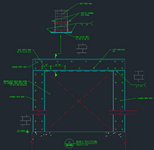Engineerataltitude
Structural
Looking for a reference for retrofitting openings into an existing CMU bearing/shear wall.
Most of my structural work has been with wood framed construction in CA. High snow load and seismic country. In my area of practice seismic loads in buildings are huge always govern the lateral design.
In the last 2 weeks I have gotten 2 inquiries about retrofitting existing buildings with exterior CMU bearing/shear walls. Both want to add significant openings into the existing exterior shear walls.
I have a bunch of reference books on designing buildings with new CMU walls, but nothing that mentions retrofitting openings into existing CMU walls.
My concern is that for new construction, there is a lot of reinforcement above and around the corners of an opening in a CMU bearing/shear wall. Is there an industry norm for handling these corner loads in a retrofit opening?
If I put in a steel OMF into the opening of an existing shear wall, isn't that introducing another kind of lateral force resisting system into that shear wall line that has a different seismic response factor, R? My recollection is that along any given shear wall line in a building, the shear is distributed in the wall by relative stiffness, G. Correct? Seems pretty analytically tricky to have CMU shear walls and and steel OMF in the same shear wall line.
Can anyone recommend a reference for this kind of work? With details, perhaps?
Most of my structural work has been with wood framed construction in CA. High snow load and seismic country. In my area of practice seismic loads in buildings are huge always govern the lateral design.
In the last 2 weeks I have gotten 2 inquiries about retrofitting existing buildings with exterior CMU bearing/shear walls. Both want to add significant openings into the existing exterior shear walls.
I have a bunch of reference books on designing buildings with new CMU walls, but nothing that mentions retrofitting openings into existing CMU walls.
My concern is that for new construction, there is a lot of reinforcement above and around the corners of an opening in a CMU bearing/shear wall. Is there an industry norm for handling these corner loads in a retrofit opening?
If I put in a steel OMF into the opening of an existing shear wall, isn't that introducing another kind of lateral force resisting system into that shear wall line that has a different seismic response factor, R? My recollection is that along any given shear wall line in a building, the shear is distributed in the wall by relative stiffness, G. Correct? Seems pretty analytically tricky to have CMU shear walls and and steel OMF in the same shear wall line.
Can anyone recommend a reference for this kind of work? With details, perhaps?

